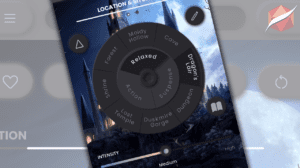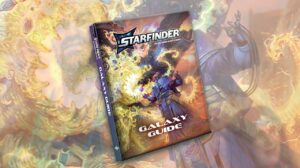Disclosure: Meeple Mountain received a free copy of this product in exchange for an honest, unbiased review. This review is not intended to be an endorsement.
I’m largely unfamiliar with the Aviation Wargame genre of gaming, although not due to lack of interest. As much as I’d love to sink my teeth into something like Star Wars: X-Wing, I’m well-known for going all-in on miniatures games only to find myself lacking someone who would mirror the same investment. Therefore, I was intrigued to see Aerodome: Rising Horizons as a budget substitute for the sprawling miniature experience.
Aerodome: Rising Horizons Overview
The object of the game is aerial supremacy. Take down your opponent by reducing their Hit Points to 0 before they do the same to you.
When starting a new game of Aerodome: Rising Horizons, you need to select the Stadium that you’ll be fighting in. It’s called a Stadium as opposed to a Battleground or Location because you’re playing as pilots of aircraft across time and dimensions. At least, that’s what I was able to glean from the ‘Story so Far’ section of the rulebook that really just outlined the various factions battling in the game.
Each player hops into the proverbial cockpit of a fighter, assuming the role of a prodigious pilot like Alice Drummond or Van Vertigo. The pilot determines which types of cards—and how many of each—can be combined to make your Maneuver Hand. Think of the Maneuver Hand as your stable of potential actions that you can take each turn.
Every card in your hand has an initiative value, and the cards resolve in Initiative order starting with the highest value. Actions are then taken from the card, starting with the top and working down the list. Only actions featuring a lock symbol are required, the rest are completely optional that will depend on the situation.
If you’ve ever played a programming game, ala Robo Rally, you will be familiar with the level of clairvoyance that this game demands. In an actual dogfight, the surrounding situation is developing so quickly that it becomes a game of anticipation, prediction, and reflexes. At least, that’s what Top Gun would have me believe. In a similar fashion, every turn requires a brief analysis of deciding whether you want to be proactive with a high Initiative, or bank on being reactionary with a lower value. Seems easy enough until you realize that you have to couple that with the limited actions available to you on each card.
Actions range from conducting straight, single-direction movement, to a simple rotation, to advanced flip maneuvers that combine movement and rotation in one fell swoop. Additionally, there are Buffs and Debuffs that impact your plane in various ways such as mitigating damage or preventing cards from being replayed.
There are cardboard templates for distance measuring and determining if an enemy plane is susceptible to a blast from your forward-facing weaponry. Damage is based on dice rolls, with any roll of 5+ on a d6 being a successful hit. Hit points start at 15 and the game continues until one plane is spiraling towards the ground in a bout of flame.

Aerodome: Rising Horizons: Turn and Burn
For being advertised as a lighter take on the genre, I was expecting Aerodome: Rising Horizons to hit the table much more quickly than it did. The delay was mostly due to the rulebook layout. To put it simply: I found the rules to be a scattershot of terms that made me feel like I was constantly missing something.
For example, as previously stated, the rules state that games take place in a Stadium and that you need to pick one to start the game. It implies the existence of multiple Stadiums, but the game only comes with The Mountains as the lone battleground. On top of that, the Stadium dictates which cards go into the Auxiliary Deck—which is shared between players—but there was no list of the specific cards that needed to be used. Eventually I located some cards with ‘The Mountains’ crammed in the bottom left that I inferred were the correct ones. This was important, but not clear at all.
My other specific gripe with the rulebook revolves around the pre-built Hands that you can use if you don’t feel like crafting your own. As a new player, I was very intimidated by the sheer volume of cards and didn’t have any confidence that I could create a custom Hand from the get-go, so I welcomed that the rulebook actually contained lists for these.
However, the Hand lists only have the names of the cards and their associated numbers, the latter being important because there are multiple variations of cards with the same name. At a bare minimum the rules should have stated which cards matched the pilot’s color and which ones were the universal gray, because I fumbled too long trying to put those pre-built lists together.
I do wish that the cards exhibited some kind of character or non-generic artwork because they feel so busy and cramped. It’s overwhelming to look at with the 19 keywords, 6 action types, combinations of actions, etc. Options are great but the barrier to entry is much higher than it initially appears to be.
The actual gameplay, however, is quite enjoyable because you are forced to weigh out your options and plan ahead. Starting out with access to all of your cards is a blessing and certainly something that you’ll take for granted once you accumulate a few Daze tokens, which prevent a card from returning to your Hand to be used again.
Being forced to carry out specific actions is a nice inclusion that helps prevent the constant and repeated use of the same card. At least, I assume that you always have access to your entire Hand minus Dazed cards, but that’s also unclear from the rules regarding the anatomy of a turn. You also can’t just bank on colliding with your opponent’s fighter and sending barrages of shots at them because if you’re touching another fighter your shots are only successful with a 6 or higher. This promotes constant movement and action throughout the game.
Factoring in the 33% chance of dealing damage and fighters starting with 15 Hit Points, I do find the game to be drawn out. The low hit chance creates more drama and excitement when you get that damage through, but I actually preferred the games when we opted to start at 10 Hit Points instead. That brought the gameplay closer to that half-hour range, which was the perfect amount of time for a dogfight.

Aerodome: Rising Horizons: Bogey Inbound
Once you can navigate through the rulebook and acclimate yourself to the terminology, Aerodome: Rising Horizons feels like an adequate entry point into the world of aviation battle. I highly recommend taking the time to put together some of the pre-built decks ahead of time so that you can jump into consecutive games without sifting through mountains of cards in between.
If you don’t mind the lack of visual punch, the mechanics feel very fluid and intuitive with accompanying iconography that makes sense. I might not have known what an Immelmann turn was going in, but I could instantly make an educated guess based on the icon. I’d imagine that most of the target audience aren’t fighter pilots, so incorporating aviation terms for the layperson to understand is a nice touch.
Aerodome: Rising Horizons took several plays for me to feel comfortable with everything it has going on, but it definitely scratches my itch for a tactical game of aerial warfare. Since the game comes with so many cards, the replay value of the game is substantial. You can try out combinations of cards and push the limits of your pilot’s restrictions in doing so. There’s also an extra bit of strategy that goes into collecting Auxiliary tokens from the Stadium, which could put you in a worse position against your opponent but would also open up the door to that token’s effect. Risk versus reward.
Once I was able to get over the rules hurdles, I only really needed to reference the rules summary sheet that is provided. This indicates that the core gameplay is intuitive and approachable even to people who are new to this type of game. I still stand by the notion that the game is too long for a 1v1 fight, but you could also play in a Free-for-All variant that awards points based on the number of fighter’s destroyed. I only played duo games, so I can’t comment more on that or the Squadron variant which involves controlling multiple planes.If you’re looking for an intuitive game of aerial battle that won’t break the bank, then Aerodome: Rising Horizons should be on your radar. Now all I have to do is work on my callsign.












